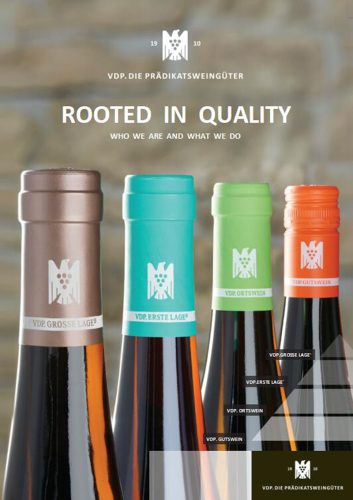
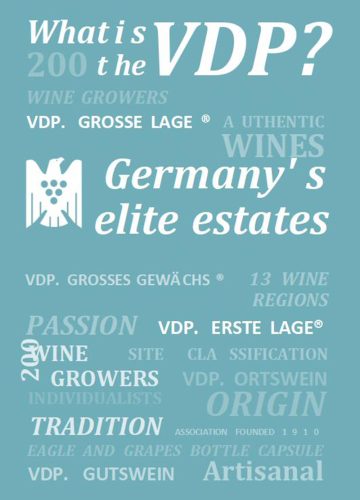
VDP.DIE?PR?DIKATSWEINGüTER
The??Verband??Deutscher??Pr?dikatsweingüter??e.V. ?(VDP) ?is??the??oldest??national??association??of??fine??winegrowing estates??anywhere??in??the??world. ?In??1910 ?four??regional??associations?joined??forces ?to ?form ?the ?Verband ?Deutscher Naturweinversteigerer?(VDNV). Those?regional?associations?from?the?Rheingau,?Rheinhessen, Rheinpfalz?(today?known as?Pfalz) and?the?Mosel, Saar?and?Ruwer?region?were?primarily?concerned?with?promoting?quality?and?preserving?the focus?on?natural?(i.e. unchaptalized) wine. Today, over?a?hundred?years?later,?the VDP brings together approx. 200 elite winegrowing estates?from?each?of?Germany’s?winegrowing?regions. VDP.members?adhere?to?strict?self-imposed?quality standards?– from?the?berries?to?the?bottle.
The VDP.Traubenadler logo (a stylized eagle bearing a cluster of grapes) on the bottle capsule is the seal of approval for VDP wines.
It?stands?for?artisinal?wine?production?from?excellent?vineyards.
o?PREREQUISITESFORMEMBERSHIPINTHEVDP
? Only estate owners are eligible to become members. They must possess appropriate winegrowing and cellar facilities
? Viticulture, viniculture and marketing are all managed and executed in-house by qualified professional personnel
? Cultivation of the finest vineyards, as determined by soil topography and microclimate
? Reduced harvest yields to boost quality (max. 75 hl/ha* for the estate average)
? Production of traditional varieties typical for the region, especially Riesling, Silvaner and the Pinot family
? Focus on natural techniques to promote greater distinctiveness in the wines
? ??Mandatory?manual?harvest?for VDP.ERSTE LAGE? and VDP.GROSSE LAGE? classifications as well as for wines?at Pr?dikat levels?from?Auslese?to?Eiswein
The VDP.Classification system is based on the association’s statutes. A wine’s quality is defined?based?on?its?terroir, here meant as?its?specific?origins?as?linked?to?a?tightly?defined?set?of?quality?criteria.
For?the?VDP.estates, the?vineyard??is?the??definitive??quality??criterion. ?Classification??is??made??based??on?the??principle:
“The?narrower?the?origin,?the?higher?the?quality.”
A?SYSTEM?FOR?WINE?CULTURE?DEFINED?BY?ORIGIN
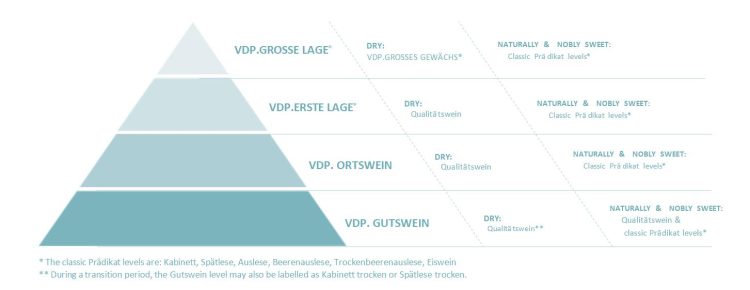
The?VDP.philosophy?combines?the?best?components?of?the?Bordeaux?and?Burgundy?classification?systems. Bordeaux classifies??its?estates; ?Burgundy?classifies?each?vineyard’s?specific?sites. The?classification??process?within?the?VDP??is conducted?as?part?of?a?strict?operational?audit?performed?when?an?estate?is?accepted?as?a?member?and?every?5?years thereafter. The?classification?of?origins, namely?as?VDP.GUTSWEIN, VDP.ORTSWEIN, VDP.ERSTE?LAGE? or?VDP.GROSSE LAGE?, reflects?an?assessment?of?the?quality?of?the?terroir?following?the?internationally?accepted?motto?“the?narrower the?origin, the?higher?the?quality”.
MODEL CONSUMER–FRIENDLY DESCRIPTIONS OF THE CLASSIFICATION TIERS
VDP.GUTSWEIN – versatile handcrafted estate wines for everyday enjoyment
Light, refreshing and fruit-forward wines that showcase the winegrower’s distinctive style. Uncomplicated and approachable — wines for nearly every gathering and occasion. Comparable with a regional wine in Burgundy.
VDP.ORTSWEIN – wines with regional roots
Accessible wines that highlight a village’s singular “taste of place”. Food friendly, with the charm to appeal to a wide variety of palates. Comparable with “Village” in Burgundy.
VDP. ERSTE LAGE? – premium German wine
Sophisticated, terroir-influenced wines with significant ageing potential. Their finesse and complexity turn any occasion into a celebration for casual drinker and connoisseur alike. Comparable to Premier Cru in Burgundy.
VDP. GROSSE LAGE? – grand wines from great vineyards
These?wines?are?the?flagships?of?the?VDP?collection. Each?bottle?contains?the?quintessential?expression?of?a?singular?site.?Nuanced,?complex?wines?with?enormous?ageing?potential. Comparable?to?a?Grand?Cru?in?Burgundy.
VDP.GUTSWEIN?–?GOOD?FROM?THE?GROUND?UP
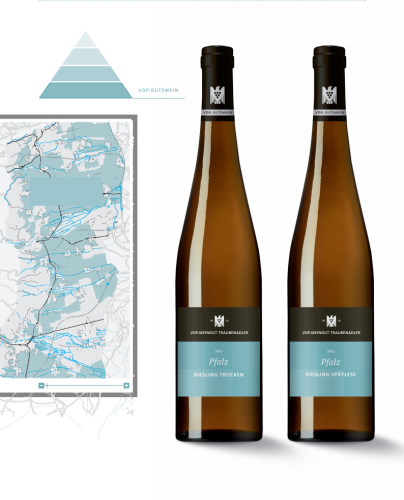
VDP. GUTSWEIN (comparable with regional wines in Burgundy) represents the first tier and foundation of the VDP’s quality pyramid.
These wines are in many ways the winegrower’s calling cards. Each wine originates from the estate’s own vineyards and corresponds to the VDP’s strict criteria standards.
The estate name and region are the only indicators on the label of the wine’s origin. The term VDP.GUTSWEIN can be implemented as a circumferential band on the capsule below the VDP.Traubenadler logo.
Classic Pr?dikat classifications?may?be?used?in?dry, naturally?and?nobly?sweet?wines.
VDP.ORTSWEIN?–?SOURCED?FROM?SUPERIOR?SOILS
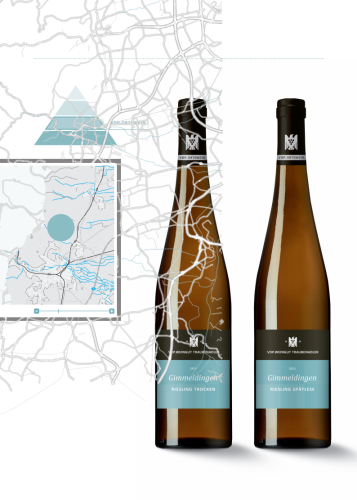
VDP.ORTSWEIN originate from the finest vineyards within a village. They are the ambassadors for that terroir. Only vari- eties typical for a region are eligible for this classification and yields must be restricted.
The?VDP.Traubenadler?insignia?on?the?bottle?capsule?in?connection?with?the?village?name?promises?a?distinctive?wine shaped?by?its?origin.
REGIONAL CLASSIFICATION CRITERIA
VDP.ORTSWEINE come from high-quality parcels of distinctive character and located within a village’s tradition- al vineyards. In many cases, Ortswein are created from grapes gathered during the selection process for the VDP. ERSTE LAGEN? and VDP.GROSSE LAGEN? or from berries from young blocks within the very best vineyards.
MAXIMUM YIELDS
Yield volumes are restricted to a maximum of 75 hl/ha (*see page 3).
TASTE PROFILES
The dry VDP.ORTSWEIN is labelled as “Qualit?tswein trocken”. Pr?dikat classifications are no longer assigned to dry wines. Naturally sweet VDP.ORTSWEINE are labelled according to the classic Pr?dikat levels (Kabinett, Sp?tlese, Auslese, Beerenauslese, Trockenbeerenauslese and Eiswein).
LABELLING
The label indicates the wine’s origin in the form of the village name. The term VDP.ORTSWEIN can be applied as a circumferential band on the capsule below the VDP.Traubenadler insignia (or as a banderole on the label).
RELEASE DATES
It is recommended?that?the?wines?not?be?released?prior?to?1 March?of?the?year?following?the?harvest.
o?Some?regions?have?placed?a?special?priority?on?the VDP.ORTSWEIN classification, and as a result do not use the VDP.ERSTE?LAGE? at?all?(as?of?2016: Rheinhessen?and?Mosel).
VDP.ERSTE?LAGE??–?FIRST?CLASS!
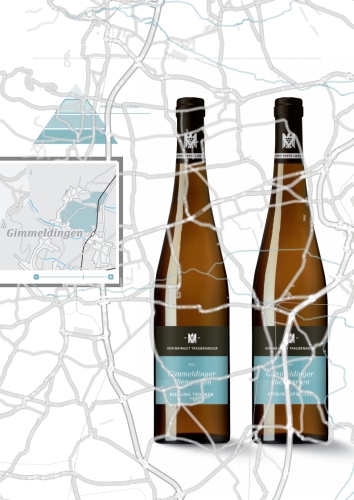
The VDP.ERSTE LAGE? classification designates a first-class vineyard site with a distinct profile and optimal growing
conditions. ??These???vineyards???are???reserved???solely???for???varieties???ideally???suited???to???them. ??Yield???volumes???are heavily??restricted??to??promote??quality. ?History??has??shown??that??VDP.ERSTE??LAGEN? ?produce??wines??of??extraordinary quality.
SITE CLASSIFICATION CRITERIA
Eligibility for the VDP.ERSTE LAGE? classification is limited to previously classified sites as well as the very good parcels close to but separated from world-class VDP.GROSSE LAGE? sites.
GRAPE VARIETIES
Restricted to varieties defined by the regional association as suitable for the specific vineyard. A chart with details for each region can be found elsewhere in this document
MAXIMUM YIELDS
Yield volumes are restricted to a maximum of 60 hl/ha (*see page 3).
HARVEST
Grapes are harvested selectively by hand. The harvest fruit must be physiologically fully ripe.
VINIFICATION
The wines are produced exclusively using traditional methods and techniques.
CERTIFICATION
Beyond the routine operations audit of all VDP.members, extra monitoring of vineyard maintenance is conducted for VDP.ERSTE LAGE? sites to ensure strict quality standards. Beyond this, a testing commission following region- al statutes must also officially certify each wine.
TASTE PROFILES
Dry VDP.ERSTE LAGE? wines are labelled as “Qualit?tswein trocken.” Labelling as dry (trocken) is mandatory. Pr?- dikat classifications are not assigned to dry wines. Wines falling under the legal classification of halbtrocken (semi-dry) do not receive additional labelling. Wines with higher levels of residual sugar are classified based on the Pr?dikats ranging from Kabinett to Trockenbeerenauslese. Sp?tlese wines must have at least 18 g/L of resid- ual sugar. The precise definition of taste corridors for Pr?dikat wines is handled at the regional level.
LABELLING
The site and village name must be written on the label. The term VDP.ERSTE LAGE? must be applied as a circum- ferential band on the capsule below the VDP.Traubenadler insignia (or alternatively as a banderole on the label).
RELEASE DATES
VDP.ERSTE LAGE? wines are released onto the market following the annual VDP.Weinb?rse in late April.
USE OF THE SITE NAME
All wines from a VDP.ERSTE LAGE? to be?marketed?with?site?names?must?fulfil?the?criteria?for?this?quality?tier. No estate may produce more than one dry?Qualit?tswein?per?site?and?variety.
SITE CLASSIFICATION CRITERIA
Eligibility for the VDP.ERSTE LAGE? classification is limited to previously classified sites as well as the very good parcels close to but separated from world-class VDP.GROSSE LAGE? sites.
GRAPE VARIETIES
Restricted to varieties defined by the regional association as suitable for the specific vineyard. A chart with details for each region can be found elsewhere in this document
MAXIMUM YIELDS
Yield volumes are restricted to a maximum of 60 hl/ha (*see page 3).
HARVEST
Grapes are harvested selectively by hand. The harvest fruit must be physiologically fully ripe.
VINIFICATION
The wines are produced exclusively using traditional methods and techniques.
CERTIFICATION
Beyond the routine operations audit of all VDP.members, extra monitoring of vineyard maintenance is conducted for VDP.ERSTE LAGE? sites to ensure strict quality standards. Beyond this, a testing commission following region- al statutes must also officially certify each wine.
TASTE PROFILES
Dry VDP.ERSTE LAGE? wines are labelled as “Qualit?tswein trocken.” Labelling as dry (trocken) is mandatory. Pr?- dikat classifications are not assigned to dry wines. Wines falling under the legal classification of halbtrocken (semi-dry) do not receive additional labelling. Wines with higher levels of residual sugar are classified based on the Pr?dikats ranging from Kabinett to Trockenbeerenauslese. Sp?tlese wines must have at least 18 g/L of resid- ual sugar. The precise definition of taste corridors for Pr?dikat wines is handled at the regional level.
LABELLING
The site and village name must be written on the label. The term VDP.ERSTE LAGE? must be applied as a circum- ferential band on the capsule below the VDP.Traubenadler insignia (or alternatively as a banderole on the label).
RELEASE DATES
VDP.ERSTE LAGE? wines are released onto the market following the annual VDP.Weinb?rse in late April.
USE OF THE SITE NAME
All wines from a VDP.ERSTE LAGE? to be?marketed?with?site?names?must?fulfil?the?criteria?for?this?quality?tier. No estate may produce more than one dry?Qualit?tswein?per?site?and?variety.
The??VDP.GROSSE??LAGE???designa-tion?is?reserved?for?top?parcels?in the??very??best??German??vineyards.
The??first-class??wines??grown??here present?a?singular?sense?of?place, complex?taste?profile?and?remark-
able??ageing???potential. ?They??are planted solely with varieties tightly linked with the?region?and?suitable for??that??specific??vineyard. ?Strict production???criteria???ensure???that these?bottles?stand?at?the?peak?of
the VDP.classification pyramid.
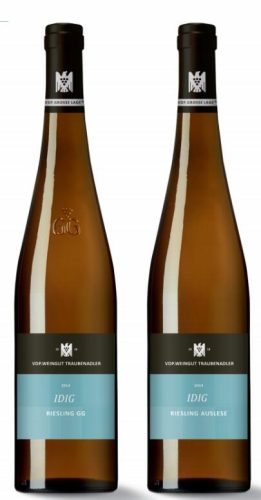
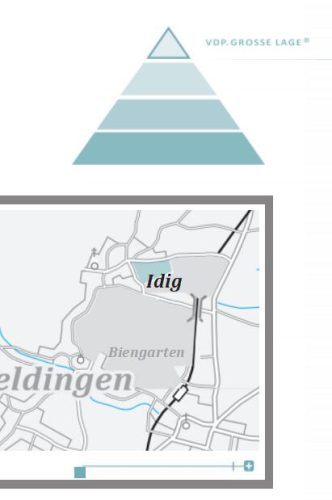
SITE CLASSIFICATION CRITERIA
In 2012, a procedure was ratified for determining eligibility for potential VDP.GROSSE LAGE? sites. It called for an in-depth review of all existing Erste Lage sites. The new VDP.GROSSE LAGEN? sites can be carved out of larger vineyards that had been drawn overly broad or which were topographically heterogeneous. They can now also be registered by their geographical designations of origin (geographische Ursprungsbezeichnung or g.U.) or, thanks to a modification to wine law, by their lieu-dit. This process remains a work in progress, as the list of sites can be expected to change periodically through new members and changes in ownership.
GRAPE VARIETIES
Restricted to varieties defined by the regional association as suitable for the specific vineyard.
MAXIMUM YIELDS
Yield volumes are restricted to a maximum of 50 hl/ha (*see page 3).
HARVEST
Grapes are harvested selectively, by hand. The harvest fruit must be physiologically fully ripe.
VINIFICATION
The wines are produced exclusively using traditional methods and techniques.
CERTIFICATION
Beyond the standard operations audits for VDP.members, wines from VDP.GROSSE LAGEN? are also subject to additional inspections and monitoring: quality-oriented work in the vineyard and, in particular, yield volumes are monitored for each vineyard throughout the entire growing season and in the weeks prior to harvest. The wines are audited and certified by a testing commission before and after bottling.
TASTE PROFILES
Wines meeting the legal criteria for dry are designated as VDP.GROSSES GEW?CHS? . Labelling as “trocken” (dry) is mandatory. Wines that are legally classified as halbtrocken (semi-dry) and feinherb (off-dry) do not receive additional labelling. Wines with higher levels of residual sugar are classified based on the classic Pr?dikat catego- ries: Kabinett, Sp?tlese, Auslese, Beerenauslese, Trockenbeerenauslese and Eiswein. The regional associations bear responsibility for establishing appropriate taste profiles, although Sp?tlese wines must have at least 18 g/L of residual sugar.
LABELLING
The site — without the name of the village — is indicated on the front and decorative label in capital letters. The term VDP.GROSSE LAGE? must be implemented as a circumferential band on the capsule below the VDP.Traubenadler logo. VDP.GROSSE GEW?CHSE? wines are filled in special bottles with the “GG Grape Cluster” logo embossed on the glass. In exceptional cases, the “GG Grape Cluster” logo and the term VDP.GROSSE LAGE? can be placed on the label.
RELEASE DATES
Naturally and nobly sweet wines from VDP.GROSSE LAGEN? are released onto the market on 1 May. VDP.GROSSES GEW?CHS? wines are not to be marketed before 1 September of the year following the harvest. Red wines ma- ture for at least 12 months in wood casks and are released one year later on 1 September.
USE OF THE SITE NAME
All wines from a VDP.GROSSE LAGE? to be marketed with site names must fulfil the criteria?for?this?quality?tier. No?estate?may?produce more than one VDP.GROSSES GEW?CHS? per site and variety.
| WINEGROWING | VDP.GROSSE LAGE? VARIETIES | VDP.ERSTE?LAGE??VARIETIES ?(PLUS?THOSE?IN?VDP.GROSSE?LAGE?) |
| AHR | Sp?tburgunder, Frühburgunder; Nobly sweet only: Riesling | No definition of VDP. ERSTE LAGE? for this region |
| BADEN | Wei?burgunder, Grauburgunder,Sp?tburgunder, Riesling, Chardonnay, Lemberger (Kraichgau and Badische Bergstra?e only)Nobly sweet only: Muskateller | Silvaner, Scheurebe, Gewürztraminer, Muskateller, Sauvignon Blanc, Auxerrois, Schwarzriesling; Nobly sweet only: Rieslaner |
| FRANKEN | Riesling, Silvaner, Wei?burgunder, Sp?tburgunder | Grauburgunder, Scheurebe, Rieslaner, Traminer, FrühburgunderOther permissible varieties (require approval): Müller-Thurgau, Chardonnay, Sauvignon Blanc, Muskateller, Lemberger |
| HESSISCHEBERGSTRASSE | Riesling, Wei?burgunder, Grauburgunder, Sp?tburgunder | Same as VDP.GROSSE LAGE? |
| MITTELRHEIN | Riesling, Sp?tburgunder | Same as VDP.GROSSE LAGE? |
| MOSEL-SAAR-RUWER | Riesling | No definition of VDP. ERSTE LAGE? for this region |
| NAHE | Riesling | Same as VDP.GROSSE LAGE? |
| PFALZ | Riesling, Wei?burgunder,Sp?tburgunder | Grauburgunder, Chardonnay, Gewürztraminer;Nobly sweet only: Scheurebe, Muskateller, Rieslaner |
| RHEINGAU | Riesling, Sp?tburgunder | Same as VDP.GROSSE LAGE? |
| RHEINHESSEN | Riesling, Sp?tburgunder | No definition of VDP. ERSTE LAGE? for this region |
| SAALE- UNSTRUT | Riesling, Wei?burgunder, Grauburgunder, Sp?tburgunder, Frühburgunder, Traminer, Silvaner | Blauer Zweigelt |
| SACHSEN | Riesling, Wei?burgunder, Grauburgunder, Sp?tburgunder, Frühburgunder, Traminer | Same as VDP.GROSSE LAGE? |
| WüRTTEMBERG | Riesling, Wei?burgunder, Grauburgunder, Sp?tburgunder, Lemberger | Silvaner, Chardonnay, Gewürztraminer, Muskateller, Sauvignon Blanc, Samtrot, Trollinger, Zweigelt, Merlot |
Verband Deutscher Pr?dikatsweingüter e.V. (VDP)
Taunusstr. 61 · D-55118 Mainz
Tel . +49 (0) 6131/9 45 65-0
vdp@vdp.de · vdp.de


